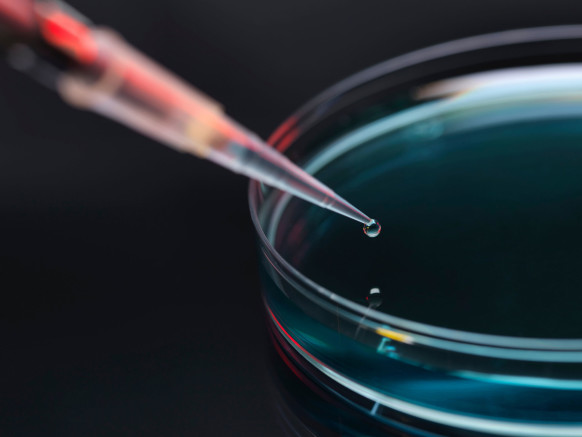
When Google co-founder Larry Page dropped his now-famous blog post revealing that Google was reorganizing itself as Alphabet, one of the most striking things was what he chose to highlight as the kind of work these newly independent non-Google companies would be pursuing.
“The companies that are pretty far afield of our main Internet products [are] contained in Alphabet instead,” Page wrote in the blog post announcing Alphabet’s existence. “Good examples are our health efforts: Life Sciences (that works on the glucose-sensing contact lens), and Calico (focused on longevity).”
Google has long dabbled in medicine, but Page’s announcement signaled that he wants biomedical research to be more than just a side project for his newly christened company. Behind the scenes, efforts were already well under way to transform Google into a place that was serious about life sciences.
Under Alphabet, life sciences will become its own independent division, though it doesn’t have an official name just yet. (The company says to expect more news soon.) But a few hints suggest the life sciences group had been operating fairly independently already. Last month, CFO Ruth Porat singled out life sciences during a quarterly earnings call as one of the areas Google sees as “longer-term sources of revenue.” To get there, the company has been quietly recruiting top scientific talent, from immunologists to neurologists to nanoparticle engineers.
“Google Life Sciences is focused on shifting health care from a reactive, undifferentiated approach to a proactive, targeted approach,” reads one of the company’s recent job listings. Biomedical researchers at Google will work to transform the “detection, prevention, management and even our basic understanding of disease,” the company says. In other words, just like everything else it does, the company once known as Google intends to train its outsized ambition on fixing the most basic problems afflicting human health.
Building An Infrastructure
For the past two years, Google’s life science efforts have been headed up by Andrew Conrad, previously the chief scientific officer at LabCorp and the co-founder of the National Genetics Institute. He leads more than 150 scientists who come from fields as wide-ranging as astrophysics, theoretical math, and oncology. “Our central thesis was that there’s clearly something amiss in Western medicine,” Conrad told Steven Levy of Backchannel back in October.
Sam Gambhir, a professor of radiology, bioengineering, and materials science at Stanford University who has collaborated with Conrad since before Google Life Sciences was a formal division within Google X, says the division isn’t just playing around. Gambhir says projects on which he’s partnered with Google’s life sciences team include the use of nanotechnology to improve diagnostics as well as devices to continuously monitor biomarkers.
Tackling Chronic Disease
One of the longest-standing efforts has been a project to develop new ways of diagnosing and treating diabetes. Last year Google unveiled a smart contact lens diabetics can use to read blood sugar levels through the tears in their eyes. Pharmaceutical giant Novartis announced that it would license the smart lens tech from Google, and the two companies are exploring other uses for the tech. Just this month, Google announced it was partnering with Dexcom, a glucose-monitoring company, to focus on making a continuous glucose monitor that’s cheaper, more convenient than current solutions, and disposable, the company said.
Google is also diving deep into genomics. Gambhir says a committee of scientists from Google, Duke University, and Stanford University have been meeting multiple times a week for about a year now to work on the design of what Google has called its Baseline Study, a project that will ultimately collect anonymous genetic information from 10,000 people to create a “baseline” picture of what a healthy human being looks like on a molecular level. Gambhir, a collaborator on the project, says Baseline is intended to be a “longitudinal study on human health to understand the transition from health to disease.”
Other work on the molecular level include a cancer-detecting pill that pairs with a wristband, all part of what Google called its “nanoparticle platform.” Part of getting the wearable to work correctly included understanding how light passed through skin, which led Conrad and his team to make artificial human skin. Life Sciences is looking at other chronic diseases, too. In January, Conrad told Bloomberg that the team planned to partner with multiple sclerosis drugmaker Biogen to study environmental and biological contributors to the disease’s progression.
Ageless Problems
Last September, Google bought Lift Labs, maker of Liftware—a high-tech spoon designed to help people with neurodegenerative tremors eat. But Google wouldn’t be Google (er, Alphabet wouldn’t be Alphabet) if it was just concerned with addressing the symptoms of disease. Aging itself is another problem it hopes to disrupt. Calico, which is organizationally separate from the life sciences group, aims to maximize the human lifespan by preventing aging. The life sciences division, meanwhile, is focused on staving off diseases that could interfere with Calico’s goal. Neither of those efforts seems very closely tied to Google’s original business model of targeting ads to users based on Internet searches. Now that life sciences have become independent under Alphabet, it looks like they don’t have to be.
